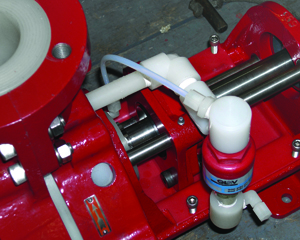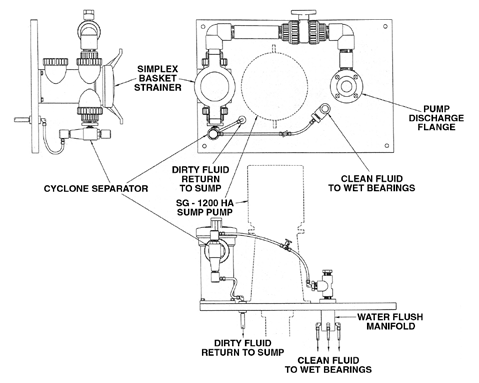Remove grit from pumped fluids to safely flush bearings and seals.
Pumps handling dirty fluids risk damage to the mechanical seal and line shaft wet bearings if they are not continuously flushed by clean fluids. When clean water is available, it can be routed through small diameter tubing for lubricating and cooling purposes. However, clean water is often unavailable, too costly and sometimes the addition of water cannot be tolerated. In these cases, a cyclone separator can be employed to remove dirt and grit from the fluid being pumped, before safely using it for the seals and bearings.
Pumps with product-lubricated (wet) bearings, such as many vertical sump pumps, require a supply of clean fluid to lubricate and cool the bearings. If the pumped fluid is free of solids, a small stream can be piped directly from the pump discharge to the bearings. A similar approach works well for the mechanical seals and packing of horizontal pumps.
However if the pumped fluid contains abrasives or other solids, an alternate solution is needed. Sump pumps often handle wastewater, which can contain abrasive particles. A common solution is to arrange a separate supply of clean water to flush wet bearings, seals and packing.
Even at modest flow rates, however, water consumption for bearings and seals soon mounts, especially in facilities in which a large number of pumps are operating. In other cases, clean water may simply not be available. For applications such as these, flush fluid recirculation systems incorporating cyclone separators can soon pay for themselves by replacing the need for clean water.
Thermoplastic Outperforms Cast Iron
One application in which cyclone separators have proved themselves in practice is at a refinery in Louisiana. The refinery operator originally installed more than 30 cast-iron, vertical sump pumps for a variety of wastewater duties. Some of these pumps were located in remote locations, making reliability critical. The iron pumps soon began to experience corrosion, with correspondingly high maintenance and replacement bills.
Searching for a better solution, the company contacted a process equipment sales representative FLIP, Inc., (in Baton Rouge, La. The company suggested using corrosion-resistant thermoplastic sump pumps. All the fluid-contact components of the 15-foot-long (5-meter) pumps were molded of solid polypropylene, including a thick-sectioned sleeve encapsulating the stainless steel shaft. With no metal parts in contact with the pumped fluid, the pumps were a good choice for this challenging service.
The thermoplastic pumps showed good resistance to abrasion compared to their metal counterparts, but in this application, the water was so contaminated that it called for special measures to protect the pumps' submerged line shaft bearings. Because of the remote locations, piping clean water for flushing would have been expensive, and the 15-foot sump depth (5-meter) ruled out bearingless pumps of cantilever design. Instead, the sales representative used his experience with pump systems to create a better solution.
Strainer Plus Cyclone Saves Water
Rather than pipe in an external water supply, each pump was fitted with a large thermoplastic basket strainer plus a cyclone separator. A small flow of wastewater from the pump discharge passed through the strainer and to the inlet of the cyclone, which removed fine particles. The dirty waste stream from the bottom of the cyclone returned to the sump, while clean water from the cyclone's top discharge nozzle was piped down the pump column to lubricate the ceramic line shaft bearings.
Since the first trials, the refinery has installed more than a dozen thermoplastic sump pumps with cyclone flushing systems. These have been more reliable than the cast iron pumps.
The cyclone separators can supply clean flush water both for wet bearings in vertical pumps and mechanical seals in horizontal thermoplastic pumps. The cyclones themselves are made of abrasion-resistant polyvinylidene fluoride (PVDF) with rubber seals. In the right applications, this arrangement has proven to be both effective and economical.
Putting Solids in a Spin
Cyclone separators (also known as hydrocyclones when used for liquid service) use centrifugal force to multiply small density differences between fluids and particles of dirt. In pump applications, they are useful if clean flushing water is not available, or when savings in water usage are required.
Entering the cyclone body through a tangential nozzle, the fluid is forced into a downward helical path following the conical inside cavity of the cyclone. Dirt-laden fluid exits the base of the cyclone and returns to the pump suction or drains back into the sump beneath. A valve installed in this line allows the flow rate to be adjusted. Clean fluid flows up, inside the helix, and leaves the top of the cyclone. From here, it is piped to the bearings or seals for flushing.

Figure 2. A cyclone separator fed from the pump discharge supplies grit-free water to flush the mechanical seal on a horizontal thermoplastic pump.
Pumps & Systems, November 2011


